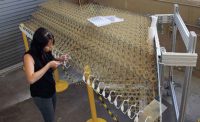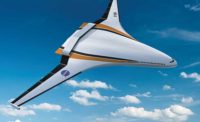Ever since the Wright Brothers first took to the sky 115 years ago, powered flight has depended on propellers and other components. But, a team of aerospace engineers at the Massachusetts Institute of Technology (MIT) have developed a silent, lightweight aircraft with no moving parts.
Instead of fans, propellers or turbine blades, the aircraft is powered by “ionic wind”—a silent flow of ions that’s produced aboard the plane. It generates enough thrust to propel a small aircraft over a sustained, steady flight.
The MIT engineers recently conducted a successful indoor test flight at a gymnasium on campus. The plane flew a distance of 60 meters during each series of flights.
“This is the first-ever sustained flight of a plane with no moving parts in the propulsion system,” claims Steven Barrett, associate professor of aeronautics and astronautics at MIT. “This has potentially opened new, unexplored possibilities for aircraft which are quieter, mechanically simpler and do not emit combustion emissions.
“Unlike turbine-powered planes, the aircraft does not depend on fossil fuels to fly,” says Barrett. “And, unlike propeller-driven drones, the new design is completely silent.”
Ionic wind, also known as electroaerodynamic thrust, is a physical principle that was first identified in the 1920s. It refers to a wind or thrust that can be produced when a current is passed between a thin and a thick electrode. If enough voltage is applied, the air in between the electrodes can produce enough thrust to propel a small aircraft.
“For years, electroaerodynamic thrust has mostly been a hobbyist’s project,” explains Barrett. “Designs have for the most part been limited to small desktop ‘lifters’ tethered to large voltage supplies that create just enough wind for a small craft to hover briefly in the air. It was largely assumed that it would be impossible to produce enough ionic wind to propel a larger aircraft over a sustained flight.”
Barrett and his colleagues designed a small plane that resembles a large glider. It weighs 5 pounds and has a 5-meter wingspan.
An array of thin wires are strung like horizontal fencing along and beneath the front end of the plane’s wing. The wires act as positively charged electrodes, while similarly arranged thicker wires, running along the back of the wing, serve as negative electrodes. The fuselage holds a stack of lithium-polymer batteries.
The Power Electronics Research Group at MIT’s Research Laboratory of Electronics designed a power supply that converts the batteries’ output to a sufficiently high voltage to propel the plane. The batteries supply electricity at 40,000 volts to positively charge the wires via a lightweight power converter.
“Once the wires are energized, they act to attract and strip away negatively charged electrons from the surrounding air molecules, like a giant magnet attracting iron filings,” says Barrett. “The air molecules that are left behind are newly ionized, and are in turn attracted to the negatively charged electrodes at the back of the plane.
“As the newly formed cloud of ions flows toward the negatively charged wires, each ion collides millions of times with other air molecules, creating a thrust that propels the aircraft forward,” explains Barrett.
“This was the simplest possible plane we could design that could prove the concept that an ion plane could fly,” adds Barrett. “[We’re still far] from an aircraft that could perform a useful mission. It needs to be more efficient, fly for longer and fly outside.”
Barrett and his colleagues are working on increasing the efficiency of their design to produce more ionic wind with less voltage. They also plan to increase the design’s thrust density—the amount of thrust generated per unit area.
Currently, the plane requires a large area of electrodes to produce the propulsion system. Ideally, Barrett would like to design an aircraft with no visible separate control surfaces, such as rudders and elevators.
In the near future, Barrett believes that ion wind propulsion systems could be used to fly less noisy drones. But, he claims that ion propulsion paired with more conventional combustion systems could someday be used to create more fuel-efficient, hybrid passenger planes and other large aircraft.
Click here to learn more about ionic wind propulsion and see the MIT aircraft being tested.




